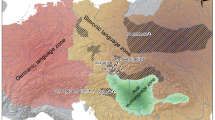Abstract
This paper examines the ways in which Latino children’s literature portrays cultural models of bilingualism and identity affiliations based on language and cultural practices. We focus attention the messages in seven children’s books about practices of and attitudes toward Spanglish, standard Spanish, and individual and societal bilingualism. In addition, we analyze how characters construct their cross-cultural identit(ies), based their language use and engagement in local and transnational cultural themes. Using assertions based on cultural model analyses, we show how portrayals evident in these books inform and are informed by larger cultural models of being bilingual and belonging to Latino bilingual communities in the U.S.
Similar content being viewed by others
References
Acosta-Belén, E. (1975). Spanglish: A case of languages in contact. In M. Burt, & H. Dulay (Eds.), New directions in second language learning, teaching and bilingual education (pp. 151–158). Washington, DC: TESOL.
Ada, A. F. (2002). I love Saturdays y domingos. New York: Atheneum Books for Young Readers.
Alvarez, J. (2001). How Tía Lola came to stay. New York: Alfred A. Knopf.
Barrera, R., & Quiroa, R. (2003). The use of Spanish in Latino children’s literature in English: What makes for cultural authenticity? In D. Fox, & K. Short (Eds.), Stories matter: The complexity of cultural authenticity in children’s literature (pp. 247–265). Urbana, IL: National Council of Teachers of English.
Bernal-Enríquez, Y., & Hernández-Chávez, E. (2003). La enseñanza del Español en Nuevo Mexico: “Revitalización o erradicación de la variedad Chicana” In A. Roca, & C. Colombi (Eds.), Mi Lengua: Spanish as a heritage language in the United States (pp. 96–121). Washington, DC: Georgetown University Press.
Bunting, E. (1996). Going home. New York: Joanna Cotler Books, Harper Children’s Books.
Erickson, F. (1986). Qualitative methods in research on teaching. In: M. Wittrock (Ed.), Handbook of research on teaching (3rd ed, pp. 119–161). American Educational Research Association: MacMillan Reference Books.
Fishman, J. (1967). Bilingualism with and without diglossia, diglossia with and without bilingualism. Journal of Social Issues, 23(4), 29–38.
Fox, D., & Short, K. (Eds.), (2003). Stories matter: The complexity of cultural authenticity in children’s literature. Urbana, IL: National Council of Teachers of English.
Gee, J. (1999). Introduction to discourse analysis. London: Routledge.
González-Echeverría, R. Hablar spanglish es devaluar el español. On http://www.elcastellano.org. Accessed 7/20/2004, 1997.
Martel, C. (1976). Yagua days. New York: Dial Books for Young Readers.
Martínez Roldán, C., & Malavé, G. (2004). Language ideology mediating literacy and identity in bilingual contexts. Journal of Early Childhood Literacy, 4(2), 155–180.
MacSwan, J. (2000). The threshold hypothesis, semilingualism, and other contributions to a deficit view of linguistic minorities. Hispanic Journal of Behavioral Sciences, 22(1), 3–45.
Montes, M. (2003). Get ready for Gabí: A crazy, mixed-up Spanglish day. New York: Scholastic.
Morales, E. (2002) Living in Spanglish: The search for Latino identity in America. New York: St. Martin’s Press.
Pedrasa, P., Attinasi, J., & Hoffman, G. (1980) Rethinking diglossia. In R. Padilla (Ed.), Theory in bilingual education (pp. 75–97). Ypsilanti, MI: Eastern Michigan University.
Pries, L. (2001). The disruption of social and geographic space: Mexican—US migration and the emergence of transnational social spaces. International Sociology, 16(1), 55–74.
Portés, A., Guarnizo, L., & Landolt, P. (1999). The study of transnationalism: Pitfalls and promise of an emergent research field. Ethnic and Racial Studies, 22(2), 217–237.
Ramírez, A. (1992). El español de los Estados Unidos: El lenguaje de los hispanos. Madrid, Spain: Mapfre.
Roberts, B., Frank, R., & Lozano-Ascensión, F. (1999). Transnational migrant communities and Mexican migration to the US. Ethnic and Racial Studies, 22(2), 238–266.
Sáenz, B. (1998). A gift from Papá Diego. El Paso, TX: Cinco Punto Press.
Schecter, S., & Bayley, R. (2002). Language as cultural practice: Mexicanos en el norte. Mahwah, NJ: Lawrence Erlbaum Associates.
Schiller, N. G., Basch, L., & Szanton Blanc, C. (1995). From immigrant to transmigrant: Theorizing transnational migration. Anthropological Quarterly 68(1), 48–63.
Soto, G. (2000). Chato and the party animals. New York: G. P. Puntam’s Sons.
Stavans, I. (2003). Spanglish: The making of a new American language. New York: Harper-Collins.
Suárez-Orozco, M. (2005). Everything you wanted to know about assimilation but were afraid to ask. In M. Suárez-Orozco, C. Suárez-Orozco, & D. B. Qin (Eds.), The new immigration: An interdisciplinary reader (pp. 67–84). New York: Routledge.
Sutherland, R. D. (1985). Hidden persuaders: Political ideologies in literature for children. Children’s Literature in Education, 16(3), 143–157.
Valdés, G., González, S., López García, D., & Márquez, P. (2003) Language ideology: The case of Spanish in departments of foreign languages. Anthropology and Education Quarterly, 34(1), 3–26.
Woolard, Kathryn A. (1998) Introduction: language ideology as a field of inquiry. In B. Schieffelin, K. Woolard, & P. Kroskrity (Eds.), Language ideologies: Practice and theory (pp. 3–47). Oxford University Press.
Zentella, A. C. (1997). Growing up bilingual. Oxford, England: Blackwell Publishers.
Author information
Authors and Affiliations
Corresponding author
Rights and permissions
About this article
Cite this article
Chappell, S., Faltis, C. Spanglish, Bilingualism, Culture and Identity in Latino Children’s Literature. Child Lit Educ 38, 253–262 (2007). https://doi.org/10.1007/s10583-006-9035-z
Published:
Issue Date:
DOI: https://doi.org/10.1007/s10583-006-9035-z




